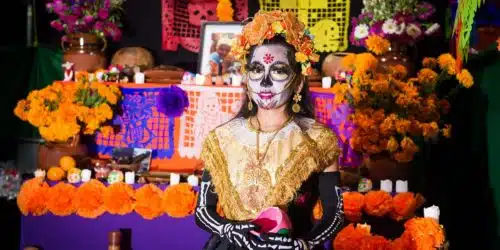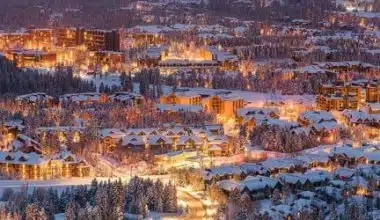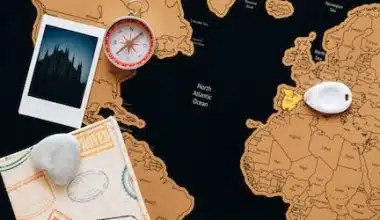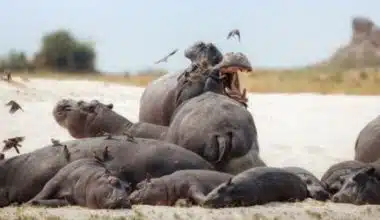Mexico, a country known for its lively culture and traditions, hosts a myriad of festivals that engage the senses and commemorate its heritage. Mexican festivals, with their colorful processions, lively music, and delectable cuisine, provide a one-of-a-kind opportunity to immerse oneself in the beauty and diversity of this intriguing country. In this blog post, we will dig into the wonderful world of Mexican festivals, with a particular emphasis on the classic Day of the Dead celebration. Join us on a cultural trip as we uncover the significance, customs, and joyful spirit that distinguish these amazing festivities.
Mexican Festivals
Mexican festivals are a mix of brilliant colors, rhythmic music, and lively celebrations that highlight the country’s rich cultural past. These traditional festivals exhibit a combination of indigenous practices and Spanish influences. Each festival offers a unique view into Mexico’s complex tapestry of culture, from the bustling streets of Mexico City to the charming communities tucked away in the countryside. Let us embark on an enthralling adventure as we explore the allure of Mexican festivals.
These festivals attest to the Mexican people’s great attachment to their traditions and the value of community. They serve as a vehicle for the preservation and development of indigenous languages, music, dance, and culinary skills. As locals and visitors alike gather to celebrate, the air becomes heavy with excitement, generating an atmosphere of joy and friendship.
The explosion of brilliant hues that graces every nook is one of the distinctive elements of Mexican festivals. Colors of red, green, yellow, and blue dominate the surroundings, from the complex costumes worn by dancers to the extravagant decorations that adorn the streets and plazas. These brilliant hues are a visual feast, representing the energy of life and the perseverance of the Mexican people.
Best Mexican Festivals
Mexico is well-known for its vibrant and diverse festivals, each offering a distinct cultural experience. While selecting the “best” festivals is impossible, here are some of the most well-known and celebrated Mexican festivals:
#1. Day of the Dead: Día de los Muertos
The Day of the Dead is one of Mexico’s most famous and well-known festivals. It is a cheerful celebration of deceased loved ones, celebrated on November 1st and 2nd, with vivid ofrendas, parades, and artistic expressions such as sugar skulls and calacas.
#2. Oaxaca: The Epicenter of Day of the Dead Celebrations
The culturally rich state of Oaxaca is one of the most well-known venues for experiencing the Day of the Dead in all its splendor. The streets of this city come alive with colorful processions, music, and dance. The famous cemetery visits, where families come to adorn graves and share tales, create a touching and joyous mood. Oaxaca’s markets are brimming with marigolds, sugar skulls, and traditional crafts, providing visitors with a sensory overload.
#3. Guelaguetza: The Festival of Indigenous Cultures
The Guelaguetza is another engaging festival that celebrates Mexico’s indigenous history. This celebration, held in the colorful city of Oaxaca, brings together numerous indigenous communities throughout the region, each presenting their distinct song, dance, and traditional costume. The Guelaguetza is a lively display celebrating Mexico’s indigenous peoples’ tenacity and cultural diversity.
#4. Feria Nacional de San Marcos: Mexico’s Largest Fair
The Feria Nacional de San Marcos in Aguascalientes is a must-see for visitors looking for a celebratory atmosphere filled with music, rides, and entertainment. This month-long fair is one of Mexico’s largest, with a fascinating mix of traditional and modern activities. The Feria Nacional de San Marcos offers an exciting carnival-like experience, complete with rodeos and bullfights, live music performances, and excellent street food.
#5. Feria de las Flores: A Floral Extravaganza
The Feria de las Flores (Flower Festival) takes center stage in the scenic city of Medellin de Bravo, Veracruz. With magnificent parades featuring intricate flower floats and innovative displays, this enchanting event pays respect to the region’s bountiful floral wealth. Visitors can enjoy the entrancing smells, bright colors, and graceful elegance of numerous flowers, which serve as a tribute to Mexico’s natural splendor.
The Carnaval de Mazatlán, hosted in the coastal city of Mazatlán, is one of Mexico’s most raucous and spectacular carnivals. The streets are filled with grandiose parades, spectacular costumes, and vibrant music during this week-long celebration.
#7. La Guelaguetza: Oaxaca’s Cultural Extravaganza
La Guelaguetza is a stunning cultural extravaganza held annually in Oaxaca City. Through traditional dances, music, costumes, and regional cuisine, this event celebrates the diversity and depth of Oaxacan culture. Indigenous groups from the surrounding areas join together to create a beautiful tapestry of cultural legacy. La Guelaguetza is a celebration of Oaxacan togetherness, pride, and the enduring spirit.
#8. Semana Santa: A Holy Week of Spiritual Traditions
Semana Santa, or Holy Week, is a strongly religious festival celebrated throughout Mexico. This week-long Easter festival includes processions, reenactments of biblical events, and religious rites. Semana Santa offers a remarkable experience for visitors desiring to observe Mexico’s ardent Catholic traditions, from the towering processions of hooded penitents to the Stations of the Cross.
In the following section, we will dig into the enthralling world of the Day of the Dead (Da de los Muertos), an iconic Mexican festival that exemplifies the country’s distinct outlook on life and death. Join us as we decipher the traditions, symbolism, and profound significance of this magnificent festival.
Mexican Festivals Day of the Dead
The Day of the Dead (Da de los Muertos) is one of the most distinctive and well-known Mexican festivals. This fascinating festival, held on November 1st and 2nd, is a colorful and cheerful homage to the remembrance of loved ones who have passed away. The Day of the Dead is a celebration of life, an acceptance of mortality, and a monument to the enduring connection between the living and the deceased.
The origins of the Day of the Dead may be traced back to indigenous tribes in Mexico, particularly the Aztecs, who thought that around this time, the souls of the departed returned to Earth. With the entrance of the Spanish conquistadors and the introduction of Catholicism, indigenous rites mixed with Catholic traditions, giving rise to the festival’s distinct blend of beliefs and ceremonies.
The centerpiece of the Day of the Dead celebrations is the meticulously made, artistic altars known as ofrendas that families make to remember and welcome their departed ancestors. These memorial altars are decorated with photographs, candles, colorful marigold flowers (cempaschil), favorite foods, and valued items of the departed.
Copal incense permeates the air, thought to guide the spirits back to the earthly realm. Families gather around the ofrendas to share tales, sing songs, and pray. It is a time for contemplation, a time to express thanks for the lives of those who have passed, and a time to celebrate their spirits’ continuous presence in the lives of the living.
Preparations and Rituals of the Day of the Dead
In Mexico, the Day of the Dead (Da de los Muertos) is a festival replete with painstaking preparations and ceremonies honoring deceased loved ones. This magnificent celebration comprises a deep spiritual connection as well as a deeper comprehension of the life-death cycle. Let us delve into the elaborate traditions and preparations that make the Day of the Dead a time of remembrance, love, and reverence.
Months before the celebration, families begin collecting the goods needed to build ofrendas, the elaborate altars dedicated to their ancestors. These altars are meticulously built in houses and cemeteries and are ornamented with important things and symbolic offerings. Each ofrenda is a unique homage that reflects the dead individuals’ unique lives and personalities.
The centerpiece of the ofrenda is a picture of the deceased, which has candles surrounding it to help bring their spirits back to earth. Marigold flowers (cempaschil) in brilliant orange and yellow hues are displayed in the images. With their strong scent and brilliant colors, these flowers are believed to attract and guide the souls of the departed.
Copal incense is lit to cleanse and purify the space, its fragrant smoke is thought to fend off evil spirits and create a spiritual connection between the living and the dead. The flickering glow of candlelight and the rhythmic scent of incense create a peaceful and solemn environment in which families can meet and ponder.
Read Also: SAFEST LATIN AMERICAN COUNTRIES IN 2023
Families work together to make sugar skulls and other artistic crafts in the days leading up to the festival. Sugar skulls are both a customary offering and a symbol of the event, beautifully covered with multicolored icing and adorned with the names of the deceased. These delicious works of art symbolize the celebration of life as well as the acceptance of mortality, reminding us that death is an inevitable part of the human experience.
On the eve of All Saints’ Day, November 1st, families assemble for a night of remembering and celebration. They keep vigils at the graves, telling tales, singing songs, and praying. It is a period of intense connection, when the lines between the living and the dead become blurred, and the spirits of the departed are believed to be present among their loved ones.
The festivities peak the following day, November 2nd, known as All Souls’ Day. Families return to the cemeteries with baskets full of food, drinks, and mementos. They congregate around the graves, holding lively talks, laughing, and even playing mariachi music. It is a joyful occasion, a celebration of those who have died, and a reaffirmation of the enduring relationship between the living and the dead.
The Mexican culture’s strong regard for their ancestors and belief in the continuation of life after death is exemplified by the Day of the Dead festival. The precise planning, meaningful rituals, and shared moments of recollection weave together to form a tapestry of love, reverence, and joy. It is a celebration of the beauty of existence, the inevitability of death, and the eternal bond between generations.
What is the most famous Mexican festival?
The Day of the Dead (Da de los Muertos) is possibly the most famous Mexican festival. This festival has received widespread international acclaim and has been often depicted in popular culture, making it the most well-known Mexican festival in the world.
What is the Mexican festival called?
The Day of the Dead, or “Da de los Muertos” in Spanish, is the name of the Mexican festival. It is a significant celebration in Mexico that takes place on November 1st and 2nd each year
How many festivals are in Mexico?
As a country rich in cultural traditions and variety, Mexico holds several festivals throughout the year. It is impossible to establish an accurate figure because festivals range from small-scale local gatherings to large-scale national events. Furthermore, new festivals may surface, while others may fade away with time. However, it is safe to claim that hundreds, if not thousands, of festivals are held each year throughout Mexico.
The Mexican festival calendar is jam-packed with events that reflect the country’s diverse cultural tapestry and provide abundant chances for locals and tourists alike to participate in the festivities and celebrations all year.
What are the 3 most celebrated holidays in Mexico?
The three most celebrated holidays in Mexico are:
- Independence Day (Da de la Independencia): Celebrated on September 16th, Mexico celebrates its independence from Spanish colonial authority. It is Mexico’s most important national holiday, and it is celebrated with great pride and patriotism.
- Day of the Dead (Da de los Muertos): As previously said, the Day of the Dead is a well-known Mexican celebration that takes place on November 1st and 2nd. It is a time to celebrate and remember loved ones who have passed away with colorful ofrendas (altars), trips to cemeteries, traditional delicacies, sugar skulls, calacas (skeletons), and parades.
- Christmas (Navidad): Christmas is extensively observed in Mexico. It is a religious and celebratory festival celebrated on December 25th to commemorate the birth of Jesus Christ.
What is Mexico best known for?
Mexico is well-known for a variety of cultural, historical, and environmental features. Here are some of Mexico’s most well-known characteristics:
- Archaeological Sites and Ancient Civilizations
- Cuisine
- Resorts and beaches
- Art and Culture
- UNESCO World Heritage Sites
- Tequila and Mezcal
- Mariachi Music
These are only a few examples of what makes Mexico famous. The country’s rich history, cultural heritage, natural beauty, and gastronomic delights all add to its reputation as a diverse and enthralling travel destination.
Conclusion
Mexican festivals serve as vibrant testaments to the country’s history, spirituality, and artistic traditions and are a monument to the country’s rich cultural heritage. These events, with their vivid colors, compelling music, and delectable cuisine, provide an immersive experience that leaves an indelible memory. Immerse yourself in the enchantment of Mexican festivals and allow the essence of Mexico’s cultural tapestry to surround your senses as you celebrate life, tradition, and solidarity.
- BRAZIL HOLIDAYS TO LOOK OUT FOR
- Best All-Inclusive Resorts in Cabo 2023, Revealed (+Free Tips)
- 20 BEST HOTELS IN MEXICO CITY IN 2023-2024
- Best Places to Travel in April: 2023 Exhaustive List (Updated)
- BEST TIME TO VISIT MEXICO






